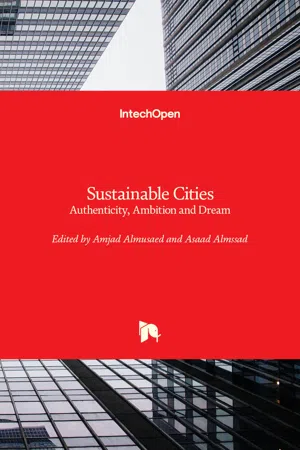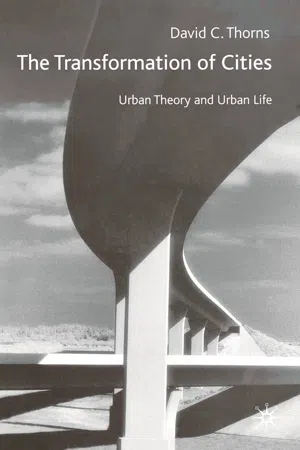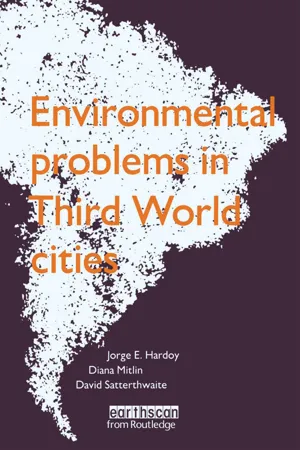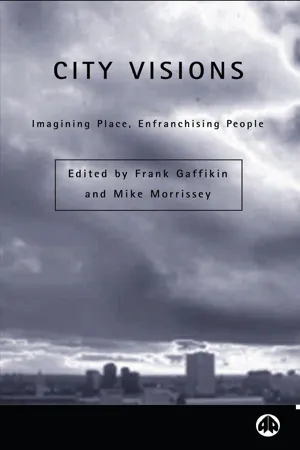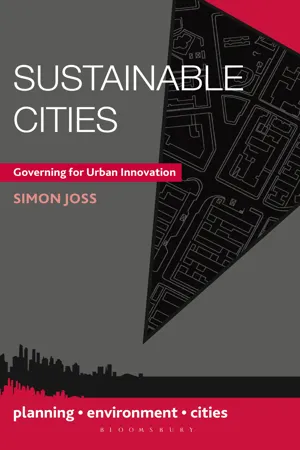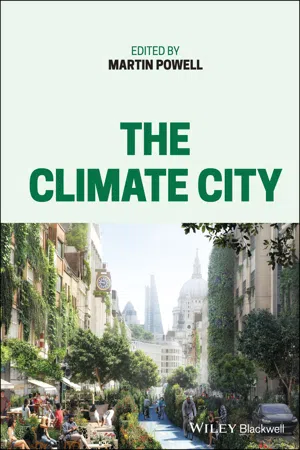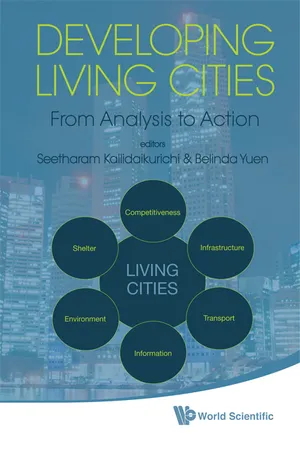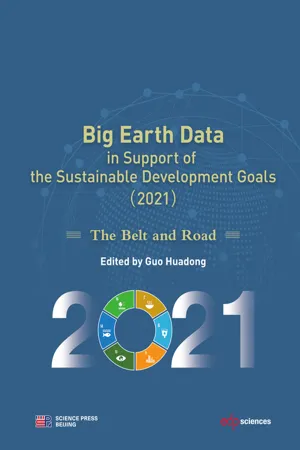Geography
Sustainable Cities
Sustainable cities are urban areas designed to minimize their environmental impact, promote social equity, and ensure economic prosperity for current and future generations. They prioritize efficient use of resources, renewable energy, green spaces, public transportation, and waste management. Sustainable cities aim to create a high quality of life for residents while reducing their ecological footprint.
Written by Perlego with AI-assistance
Related key terms
1 of 5
11 Key excerpts on "Sustainable Cities"
- eBook - PDF
Sustainable Cities
Authenticity, Ambition and Dream
- Amjad Almusaed, Asaad Almssad, Amjad Almusaed, Asaad Almssad(Authors)
- 2019(Publication Date)
- IntechOpen(Publisher)
Human settlements support the unity of natural, social, material, spiritual, cultural and organizational factors, including housing, labor, energy supply, communications, water, sanitation, services, social security, administration systems, cultural facilities, recreation, etc. [ 1 ]. The village is the oldest form of human habitation that presents ethnographic, historical, economic, social or urban characteristics. A village is a group of houses and people who are leaving their means of existence of a determined social space. Defining the sustainable city, the word sustainability has come into such common usage that it sometimes seems ubiquitous. At the outset, this leads to the need to answer two principal © 2018 The Author(s). Licensee IntechOpen. This chapter is distributed under the terms of the Creative Commons Attribution License (http://creativecommons.org/licenses/by/3.0), which permits unrestricted use, distribution, and reproduction in any medium, provided the original work is properly cited. questions with regard to the movement of Sustainable Cities. First, what is a sustainable city? And secondly, why is it important that cities become sustainable? In answering these questions, it is useful to draw a distinction between sustainability and sustainable develop -ment. Sustainability in its broadest sense is the capacity of natural systems to endure and to remain diverse and productive over time. Sustainable development is the practice of humans arriving at a level of economic and social development that does not inevitably alter ecologi -cal balance [ 3 ]. Many settlements were fair, with trade, crafts and administrative functions. In the renaissance era, when the bourgeoisie grew, the cities experienced a period of flowering (Florence, Venice and Rome). In the modern and contemporary era, besides the European and Asian cities, colonized colonists have developed in the Americas (New York, Quebec, Bogota). - eBook - PDF
Towards an Environment Research Agenda
A Second Selection of Papers
- A. Winnett(Author)
- 2002(Publication Date)
- Palgrave Macmillan(Publisher)
Nonetheless, the urban design of compact cities can obvi- ously contribute to a more sustainable way of life, particularly in indus- trialized societies. This can be done by encouraging the development of integrated, mixed-use, urban communities as has been advocated by a diverse range of architectural critics. But they must be seen as part of a wider spatial matrix. 81 Introduction ‘Sustainable Cities’ The concept of sustainability has become a key idea in national and international discussions following publication of the Brundtland Report (WCED, 1987) and the 1992 Rio ‘Earth Summit’. It has been given further prominence in the run-up to the 2002 Rio 10 review conference being held in Johannesburg. Sustainable development is certainly a desirable and, more debatably, an attainable objective in global terms. However, it is less obviously applicable on a smaller scale, where it is sometimes used synonymously with self-sufficiency. The Latin root of the word ‘civilization’ is cives (Hall, 1998) – citizen – and so cities are clearly at the heart of human development. However, it is currently fash- ionable in literature to find material on ‘Sustainable Cities’ (see, for exam- ple, Giradet, 1992 and 1999; Haughton and Hunter, 1994; Rogers, 1997, and the UK Urban Task Force, 1999). Indeed, part of the UK Research Councils’ Clean Technology Managed Programme was devoted to this topic (see Ekins and Cooper, 1993). Nevertheless, it is argued here that this notion is quite spurious in systems analysis terms (see also Day and Hammond, 1996). It looks back to the 1970s’ idea of self-sufficiency, when it became popular to strive for ‘autarkic’ buildings or settlements. Clusters of buildings and an integrated human-scale transport infra- structure can enhance energy conservation and reduce environmental impact. But even ‘compact cities’ are not in themselves sustainable. - eBook - PDF
The Transformation of Cities
Urban Theory and Urban Life
- David C. Thorns(Author)
- 2017(Publication Date)
- Red Globe Press(Publisher)
9 The Sustainable City Introduction The analysis of global urban development in the last couple of decades has been greatly influenced by the ‘sustainability debate’ and the increas-ing recognition that we are all part of one eco-system (Therborn 2000). This debate focuses upon the interplay between the environment and the natural resources it contains – water, energy, soil, air – and the pollution and consequent corruption of the eco-system that has taken place through industrial and urban development. A recent idea that has gained currency in the debate is that of the ‘ecological footprint’ which is the calculated amount of ecologically productive land needed on a continuous basis to supply a population with all its resources (goods, services and energy, and so on) and to assimilate all wastes (Parliamentary Commissioner for the Environment 1998:2). The use of this concept is an attempt to provide inte-gration across the natural and social environment. In much of this debate, ‘sustainability’ is seen largely as a matter of bio-physical processes and the social and the cultural facets of the city and the social actions and political institutions which have emerged over time are seen as secondary to the natural or derivatives from the bio-physical environment. Inequalities of power and position, especially distribution issues and access for all social groups, are of major importance in the analysis of urban change and the provision of a desirable path for future develop-ment. This raises the question of the relationship between issues of social justice and those of environmental sustainability. They also draw back our attention quite firmly to the fact that we are now living within a global world, one where new risks have arisen as a result of the speed with which both material objects, ideas, microbes and all other forms of life can be transferred across distances previously acting as barriers. - eBook - PDF
- Ronan Paddison(Author)
- 2000(Publication Date)
- SAGE Publications Ltd(Publisher)
8.4.4. An Integrated View on Sustainable Cities The focus of any theoretical reflection on urban sustainability should be the relationships between the three environments or sub-systems that constitute the essence of the city: the economic, the social and the physical – natural and built – environments (Figure 8.1). In a previous paper (Camagni et al., 1997) the present authors have proposed a dual way of assessing the interaction among these environments. Managing Sustainable Environments 131 Environmental equity (intra- and intergenerational) Pure equity and welfare Pure ecological and aesthetic principles Social environment Physical (natural and built) environment Pure profitability and economic growth Economic environment Long-term allocative efficiency Distributive efficiency Figure 8.1 Sustainability principles and policies (Camagni, 1996; Camagni et al., 1997) 1 A static and structural approach , focused on the study of how the external effects of the three sub-systems impinge upon each other, posi-tively and negatively (Table 8.2). The scale and quality of the respective assets may represent: • positive cross-externalities for the other assets, when the presence of the former assets determines the productivity, attrac-tiveness or marginal utility of the latter (for example, environmental assets increase the economic attractiveness of the city; economic development allows welfare policies and a wider accessibility to urban amenities, services and jobs; lower social conflict increases effectiveness of the local activities, etc.); • negative externalities when, due to the limited physical space in which all rela-tionships happen, decreasing returns and bottlenecks appear both in economic terms (rising costs of factors, generating selective crowding-out effects on popula-tion and firms) and in physical terms (congestion, conflict, limited accessibility to scarce urban assets). All these effects act as positive or negative location factors. - eBook - ePub
- Jorge E. Hardoy, Diana Mitlin, David Satterthwaite(Authors)
- 2024(Publication Date)
- Taylor & Francis(Publisher)
- ‘Renewable resources’. Human use of some renewable resources (such as the direct use of solar power or its indirect use through wind or wave power) does not deplete the resource. But many renewable resources (especially crops and trees) are renewable only within finite limits set by the ecosystem within which they grow. Fresh water resources are also finite; in the case of aquifers, human use often exceeds their natural rate of recharge and as such is unsustainable.
The term sustainable is used both for particular projects/activities and in reference to larger systems (perhaps city-wide, nation-wide or worldwide). It is useful to differentiate between the two applications of the term since both are important in considering sustainable development and cities. Simple inter-relationships between specific development activities (for instance, expanding a piped-water supply or developing a sanitary landfill site) and natural resource-use can be assessed and judged using the criterion of sustainability. Alternatively, the focus can be much broader, concerned with large aggregates and systems of activities. The first approach is concerned with making a single part of the system sustainable. The second approach has a different focus, recognising that it is difficult to make all activities sustainable, and that what is important is that the sum (or net effect) of the activities within a specific area is sustainable. In general, our focus is on the second of these contexts, ensuring that urban systems (and the economies and societies of which they are part) are sustainable, rather than specific urban projects, or even cities. The successful achievement of sustainable development requires society to establish institutions which are capable of ensuring that individual projects add up to an acceptable aggregate outcome without demanding such stringent conditions on individual projects that they inhibit the achievement of development goals.Cities and Ecological Sustainability
This disaggregation of sustainable development into its two components simplifies its discussion in regard to cities. The sustainability component is the impact of each city (or rather of the producers and consumers located within the city) on environmental capital: local and global sinks, renewable resources, and non-renewable resources. The development component is the performance of each city and its institutions in meeting its inhabitants’ development needs; as previous chapters have stressed, this also has an important environmental component since the quality of the home, work, neighbourhood and city environment, and the extent to which the inhabitants are protected from biological pathogens and chemical pollutants in the water, air, soil or food or other environmental hazards has a major influence on the health and well-being of the population.20 - eBook - PDF
City Visions
Imagining Place, Enfranchising People
- Frank Gaffikin, Mike Morrissey(Authors)
- 1999(Publication Date)
- Pluto Press(Publisher)
Neglected or abused environments can lead to ill-health, stress, social unrest, etc.; a means of creating business and job opportunities in leisure and tourism, and a set of life support systems – the general ecosystem. The Difficult Goal of Sustainable Cities The world is urbanising, a process starkly evident in the growth of mega cities, particularly in Latin America and Asia. Any credible strategy to address this agenda has to respond to the urban pressures on the environment. As noted by Tim Hall: 8 Cities are the major consumers of the world’s non-renewable energy resources; they are also the world’s major producers of pollution and waste. The city is also (and is likely to continue to be) the locus of both major population migration and population growth. Much of the current environmental ‘crisis’ is seen as either directly or indirectly attributable to cities. In outlining a number of scenarios for future cities, Tim Hall identifies the problem of sustainability they face. The global city refers to those most connected to the increasingly integrated world economy such as the world’s financial system. Such cities are vulnerable to the instability of this new international finance and are prone to the deep internal social, economic and spatial inequalities. The competitive city is given to favouring property flagship schemes and other speculative regen-eration initiatives, designed in part to re-image place. Since these projects rely on substantial public investment, such spending can detract from the resources needed by public services and lead to the ‘wasteful duplication of facilities’. - eBook - PDF
Sustainable Development as a Civilizational Revolution
A Multidisciplinary Approach to the Challenges of the 21st Century
- Artur Pawlowski(Author)
- 2011(Publication Date)
- CRC Press(Publisher)
• Providing cheaper accommodation space. • Protecting children against the hazards typical of cities. • The need for peace and quiet. The listed expectations have their ecological dimension (contact with nature), economic dimension (cheaper accommodation space), and also social dimension (sense of security, escape from the hustle and bustle of city life). Moreover, one can point to the low population density in rural areas. This prompts the development of strong social relations; everybody knows each other, no one is anonymous. Things look different in the case of cities. Here, the population is very dense, and the social relations are not as strong as in the country (related to, for example, the high level of anonymity). Proper, and hence, sustainable, urban environment management is a major challenge in this context. Table 28 presents the classic definitions on this matter. The discussion was expanded within the last few years. Wojciech Peski (1999) perceives such management as an activity directed at securing the effi-cient operation and sustainable development of a historically shaped settlement. This general statement is then fleshed out in more detail by indicating the pri-mary objectives of such development: • To increase the income of both the city and its residents. • To increase employment. • To support actions directed at increasing the level of a city’s economic self-reliance. • To support actions directed at improving the state of the environment (Peski, 1999). These tasks and needs must be realized in such a way as not to impair the future generation’s ability to meet their needs—which is a direct reference to sustainable development. Such an approach expands the discussion by environ-mental and social aspects. The concepts of ‘ecological cities’ also goes in this direction (Bithas & Christofakis, 2006). - eBook - PDF
Sustainable Cities
Governing for Urban Innovation
- Simon Joss(Author)
- 2017(Publication Date)
- Red Globe Press(Publisher)
(In comparison, the populations of Europe, North America and Oceania have increased, too, but at significantly slower rates.) For example, in China alone, it is estimated that in the period 2000–20 some 300 million people will have become city residents as a consequence of both migration to urban centres and the ongoing urbanization of rural areas. Hence, the policy importance of urban sustainability is seen not just in terms of addressing the environmental, economic and social challenges facing existing cities but, crucially, in terms of innovating in sustainable development in preparation for cities and urban regions yet to emerge. Sustainability and the City? 17 Principles of the sustainable city: three approaches Urban sustainability as policy priority has brought forth numerous propositions and visions for what the sustainable city should look like. Many of these propositions and visions are future-oriented and normative, expressing what their protagonists wish the ideal-typical sustainable city to look like. As such, they may be criticized for being too removed from the reality of present sustainable urban develop-ment, and steeped too much in normative thinking. This is arguably an unfair view: for one thing, such propositions and visions typically take a cue from innovative experimental and analytical work carried out by pioneers in the field; and for another, they purposely reach for ambitious goals, in order to provoke fundamental debate, creative thinking and ambitious long-term planning. Here, three such contributions are introduced and compared (see Table 1.1): Richard Register’s (1987) seminal Ecocity Berkeley , which subsequently led to the publication of ten ‘ecocity principles’; Jeffrey R. Kenworthy’s (2006) ‘The Eco-city: Ten Key Transport and Planning Dimensions for Sustainable City Development’; and Steffen Lehmann’s (2010) The Principles of Green Urbanism . - eBook - PDF
- Martin Powell(Author)
- 2022(Publication Date)
- Wiley-Blackwell(Publisher)
Research across Organisation for Economic Co-operation and Development (OECD) countries found that well-function- ing and well-managed cities are central to all the fundamental aspects of people’s well- being and sustainable development, from water to housing, transport, infrastructure, land-use, and climate change, among others. As UN-Habitat observes, the inclusion of a dedicated cities goal (SDG 11) is a strong recognition by the international community 13 UN Secretary General, 2018. Progress on the implementation of the New Urban Agenda. https:// digitallibrary.un.org/record/1628008?ln=en. 14 https://www.oecd.org/regional/regional-policy/Governing-the-City-Policy-Highlights.pdf. Sustainable Development Won’t Happen if it Doesn’t Happen in Cities 83 Figure 4.6 Cities’ share of the pie. (Source: Author derived from C40 city data. https://www.c40.org/.) Figure 4.5 Rocinha slum, one of the biggest in Brazil. (Source: Donatas Dabravolskas/Adobe Stock.) 4 The Sustainable City 84 that urbanization is a transformative force for development that not only links to all other SDGs, but also underpins them. Figure 4.8 shows the indicators for progress against SDG 11. But making the SDGs a reality in cities – and, correspondingly, leveraging cities’ role in addressing the interlinked “wicked problems” of climate change, poverty, and inequality – will become even more complex as urban populations swell. For instance, energy demand is forecast to triple in line with urban growth over the next few decades, along with an equivalent demand for vital resources including water and food, as well as the need for housing, jobs, faster and better communications, and transport, placing ever more pressure on land and adding to already complex challenges and debates over land- use. Today, just 1.5% of the world’s land is home to half of its production. - eBook - PDF
Developing Living Cities: From Analysis To Action
From Analysis to Action
- Kallidaikurichi E Seetharam, Belinda Yuen(Authors)
- 2010(Publication Date)
- World Scientific(Publisher)
This chapter examines the tenets of this emerging, sustainable, environmental urban paradigm and describes the process of redesigning and rebuilding cities to achieve greater sustainability. The chapter also reviews how two cities, Singapore and Honolulu, have approached these daunting challenges and achieved a measure of success in moving toward environmental sustainability. 7.2. Cities and the New Urban Environmental Paradigm 7.2.1. The city as an ecosystem: Waste = resource Cities can be analysed as urban ecosystems (Machlis et al ., 1997). A natural ecosystem, such as a rainforest or a coral reef, can be a model on which to base the design and operation of environmentally Sustainable Cities. Ecosystems such as these are characterised by (i) high productivity, (ii) high diversity and a fabric of interrelationships, (iii) resilience and (iv) continuous recycling of resources. Like the rainforest, cities are places of high primary productivity in the form of products and services. They are places of high diversity in the form of various economic activities, services and cultures. In natural ecosystems, diversity is vital to maintaining stability. A city with a wide diversity in its economic base is much less vulnerable to perturbations than one with few economic engines. Environmentally Sustainable Cities 157 Modern urbanisation was facilitated by the transition from human muscle power to mechanical power (Benton-Short and Short, 2008, p. 142). This mechanical power was largely provided by fossil fuels that were cheap and abundant. As a result, cities that are grossly energy inefficient were built. City leaders can learn much from forest ecosystems when it comes to energy efficiency and resource management. Like forests that effectively capture and convert solar energy and forest floor waste into growth, cities should also develop a layered energy approach and a system of resource recovery. - No longer available |Learn more
- Guo Huadong(Author)
- 2022(Publication Date)
- EDP Sciences(Publisher)
With an increase in city size, the improvement in urban land use efficiency was significant, indicating that larger cities have higher sustainability of urban land. On the contrary, the smaller the size of the city is, the more obvious the phenomenon of non-intensive use of urban land is. Therefore, in terms of sustainable assessment of urban land use, in addition to paying attention to big cities, land use efficiency in small-and medium-sized cities needs to be given more attention. The above research conclusions are all based on the perspective of statistical analysis, and the analysis of the hidden reasons and driving factors will be the focus of follow-up research. In addition, although the sustainability of urban land of the countries involved in th Belt and Road Initiative is improving on the whole, there are some exceptions. The LCPC of expanded built-up areas in mega-cities is significantly higher than that of existing built-up areas and tends to increase with time. Further analysis of these phenomena will be the main problem to be solved in the next stage of this case study. 145 Chapter 4 SDG 11 Sustainable Cities and Communities 4.4 Comprehensive assessment of urbanization at World Cultural Heritage Sites in the countries involved in the Belt and Road Initiative and the neighboring countvies Target SDG 11.4: Strengthen efforts to protect and safeguard the world’s cultural and natural heritage. Background In SDG 11.4, the United Nations proposed “strengthen efforts to protect and safeguard the world’s cultural and natural heritage”. Progress toward this target can be calculated using SDG indicator 11.4.1 “Total per capita expenditure on the preservation, protection and conservation of all cultural and natural heritage, by source of funding (public, private), type of heritage (cultural, natural) and level of government (national, regional, and local/municipal)”, which only includes the capital investment in heritage sites (United Nations, 2015).
Index pages curate the most relevant extracts from our library of academic textbooks. They’ve been created using an in-house natural language model (NLM), each adding context and meaning to key research topics.
